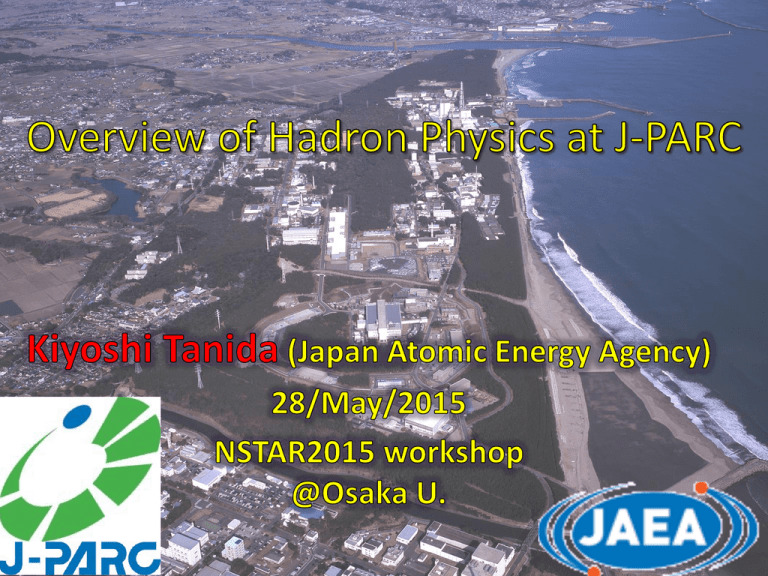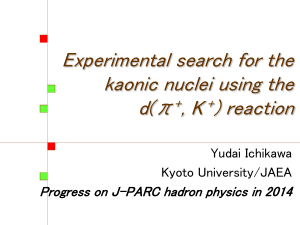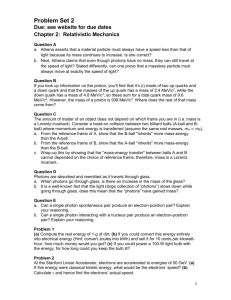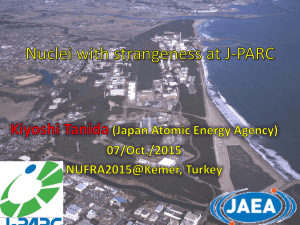PPTX
advertisement

Contents I. Introduction to J-PARC II. Results of initial experiments related to baryon spectroscopy – E19 (pentaquark search) – E27 (Kpp search) III. Some of experiments in near future – E45 (N*/Y* spectroscopy) – E42 (H dibaryon) – E50 (charm baryon spectroscopy) Part I. Introduction of J-PARC J-PARC Tokai, Japan (Japan Proton Accelerator Research Complex) Material and Biological Science Facility 400 MeV Linac (350m) 3 GeV Synchrotron (333 mA) Neutrino Facility World-highest beam intensity : ~1 MW x10 of BNL-AGS, x100 of KEK-PS 50 GeV Synchrotron (15 mA) Nuclear & Hadron Physics in J-PARC Experiments at aPhysics glanceat(not all) Nuclear & Hadron J-PARC d High Density Nuclear Matter, Nucelar Force u Strange ness Hypernuclei 6 He K0 → p0 nn L s d u Pentaquark + Origin of Mass Confinement , X Hypernuclei Z -1 0 Quark , S Hypernuclei -2 N ,X SKS Free quarks K1.8 Bound quarks Why are bound quarks heavier? Mass without Mass Puzzle K1.8BR KL K1.1 K-meson Implantation of High Density Kaon and the nuclear shrinkage Nuclear Matter, Nucelar Force COMET Beam line K− T-Viola tion Xray Kaonic atom Kaonic nucleus nucleus m-e conversion μ− e- Part II. Results of initial experiments related to baryon spectroscopy E19 – pentaquark search E27 – spectroscopy with d(p+,K+) E19 Experiment Search for pentaquark, + • There are two kinds of usual hadrons (= feel strong force) – Baryon (Fermion): Meson (Boson): – Color neutrality required from QCD But they are not the only cases Exotic hadrons – Pentaquark = 5 quarks Pentaquark + • First reported in 2003 by LEPS collaboration • Both positive and negative results – Still controversial • Mysteries – Why so narrow? G < 1 MeV – Spin-parity? – What’s that eventually? T. Nakano et al.,PRC79 (2009) 025210 High resolution search by p(p-,K-) • A good resolution: ~2 MeV (FWHM) – thanks to SKS • Why high resolution? – Good S/N ratio – Width measurement Almost certainly G < 1 MeV • Typical resolution in the past ~ 10 MeV – No high resolution search – There is a good chance Moritsu et al., PRC90 (2014) 035205 • Spectra well represented by known backgrounds at both energies Upper limit on decay width • Based on an effective Lagrangian approach: Hyodo et al., PTP128 (2012) 523 • Upper limit: 0.36 MeV for ½+ 1.9 MeV for ½For most conservative cases, taking theoretical uncertainties into account • Comparable to DIANA result E27: Deeply bound Kaonic nuclei (1405) = K-p bound state deeply bound nuclei? Kaon condensation in neutron stars? DISTO (PRL 94, 212303) FINUDA PRL104, 132502 Akaishi & Yamazaki, PRC 65 (2002) 044005 BK > 100 MeV?? E27 • Search for K-pp by d(p,K+) reaction – missing mass spectroscopy Decay counter to detect ppp from Kpp p ppp Calibration: p(π+, K+)Σ+ at 1.69 GeV/c Σ+ Σ(1385)+ Data: M = 1381.1 ± 3.6 MeV/c2 Γ = 42 ± 13 MeV PDG: M = 1382.8 ± 0.35 MeV/c2, Γ = 36.1 ± 0.7 MeV 25 d(π+, K+) at 1.69 GeV/c (Inclusive spectrum) Y* peak; data = 2400.6 ± 0.5(stat.) ± 0.6(syst.) MeV/c2 +2.8 sim = 2433.0 -1.6 (syst.) MeV/c2 +2.9 ``shift” = -32.4 ± 0.5(stat.) -1.7 (syst.) MeV/c2 Mass shift of *(1405) and/or S*(1385)? due to final state interaction? Gaussian fit PTEP 101D03 (2014) 26 θπK dependence (+data, ―sim) Y* peak positions are shifted to the low mass side for all scattering angles. < Peak position > + data + simulation 27 HADES experiment for Λ(1405) The peak position of Λ(1405) is shifted to low-mass side. M = 1385 MeV/c2, Γ = 50 MeV S-wave Breit Wigner function 28 Range counter array(RCA) for the coincidence measurement • RCA is installed to measure the proton from the K-pp. – K-pp→Λp→pπ-p; K-pp→Σ0p→pπ-γp; K-pp→Ypπ→pπp+(etc.) • Proton is also the produced from the QF processes. We suppress QF background by tagging a proton. +Λπ0, Λ→pπ–☆ π+``n’’→K Seg2 and 5 are free from QF background. More strongly suppress by tagging two protons. • However, these proton’s kinematics is different. K+ p p π+ 29 ``K-pp’’-like structure(coincidence) • Broad enhancement ~2.28 GeV/c2 has been observed in the Σ0p spectrum. PTEP 021D01 (2015) • Mass: • Width: • dσ/dΩ``K‐pp’’→Σ p = (BE: ) 0 T. Sekihara, D. Jido and Y. Kanada-En’yo, PRC 79, 062201(R) (2009). • [Theoretical value: ~1.2] <2proton coincidence analysis> π+d→K+X, X→Σ0p <1 proton coincidence probability> 30 Discussion on the ``K-pp’’-like structure • Obtained mass (BE ~ 100 MeV) and broad width are not inconsistent with the FINUDA and DISTO values. – Theoretical calculation for the K-pp is difficult to reproduce such a deep binding energy about 100 MeV. – The other possibilities? • A dibaryon as πΛN – πΣN bound states? H. Garcilazo and A. Gal, NPA 897, 167 (2013). (It should not decay to the Λp mode because of I = 3/2.) T. Uchino et al., NPA 868, 53 (2011). • Λ*N bound state? A. Dote, T. Inoue and T. Myo, PTEP 2015 4, 043D02 (2015). • A lower πΣN pole of the K-pp? (The K-pp might have the double pole structure like Λ(1405).) ― • Partial restoration of chiral symmetry on the KN interaction? S. Maeda, Y. Akaishi and T. Yamazaki, Proc. Jpn. B 89, 418 (2013). 31 Part III. (some of ) experiments in (near) future E45 HypTPC Spectrometer 27A2 Hosomi Measure (p,2p) in large acceptance TPC in dipole magnetic field p-p→p+p-n, p0p-p p+p→p0p+p, p+p+n 2 charged particles + 1 neutral particle →missing mass technique pN→KY (2-body reaction) p-p→K0, p+p→K+S+ (I=3/2, D*) Trigger with hodoscope p+- beam on liquid-H target (p= 0.73 – 2.0 GeV/c W=1.5-2.15 GeV) LH target p beam LH target: Φ5cm Superconducting Helmholtz Dipole magnet (1.5 T) Hyp-TPC 33 Importance of ππN (Width of N* resonances) 27A2 Hosomi Over half of the decay branchig fraction goes into 2π channel. Kamano, Nakamura, Lee, Sato, 2012 NSTAR2015 34 H dibaryon Flavor-singlet (00) state (strangeness -2, isospin 0, or 1S0 state in ΛΛ-ΞN-ΣΣ system) Color-magnetic force is not repulsive, but attractive u u s s d d 6 quark state may exist u s s d d u All 6 quarks in s-state H dibaryon but not found so far A resonant state just above threshold? ⇒ Still an open and important question Hosomi HypTPC27A2 test J-PARCfor E42: for H-dibaryon Search theSearch H-dibaryon, E42 55 with Fe (x-ray) source H-Dibaryon as E522 a Resonance? @ KEK H(2250) H-dibaryon • Weakly-bound : H ® Λpπ weak Gain : 120fC, Shap T:u70ns, GEMdecay Curr.: 315 mA • Virtual state : ΛΛ threshold effect s u d • Resonance 2.7 keV peak s d 5.9 keV peak : Breit-Wigner peak in the ΛΛ mass spectrum. ? R. L. Jaffe, Phys. Rev. Lett. 38, 195 (1977) Search'for' the' H,dibaryon' near' threshold'' ahnjk@pusan.ac.kr' WeGeV/c expect to measure 11000 ΛΛ events and 1440 H(2250) events for 1.0 μb/sr 1.6 30 H(2200) 25 Λpπ- mode 20 15 HypTPC & SC-Magnet 10 5 0 2.16 2.18 2.2 2.22 2.24 2.26 2.28 - 2.3 Counts/1MeV/c2 IM( L p p )(GeV/c ) ΔE/E :14.3 ± 0.2 %KURAMA Spectrometer (Peak)/(Esp. Peak): 0.52 ± 0.01 2 Statistical significance (S/Ö(S+B)) at E42 experiment H→2Λ→ppπ-π- Counts/1MeV/c2 12C(K-,K+)X H(2200) ® Lpp 10 - Diffusion size : 1.87 ± 0.02 mm 200 H(2250) ΛΛ mode cf. prototype TPC(5 cm to 10 cm) H(2250) ® LL 1 : 1.7 ~ 2.0 mm 150 100 50 10 -3 10 -2 10 -1 2.24 2.26 2.28 2.3 2.32 2.34 2.36 IM( L L )(GeV/c ) 2 1 Cross section (mb/sr) The TPC operation is consistent with the prototype TPC!! 0 2.22 3 E50: Charmed Baryon Spectroscopy • Charm quark in Baryon – Bare quark ≒ constituent quark – Heavy enough to make a “static core”, light quarks play around – New symmetry – heavy quark symmetry – Diquark correlation? • How analog states appear? – (1405) ?, Roper resonance ? – Helps to understand the nature of those states. • Missing resonances? • New exotic states? E.g., DN bound state, pentaquarks, .... Missing mass spectroscopy by p(p-,D*-) • Analogous to p(p,K)Y reaction • Direct reaction – possibility to produce resonances not made in fragmentation • Production rate gives valuable information • No bias on decays – Absolute branching ratio can be measured – Shape analysis for c(2595) • Cross Section: s ~ 1 nb • Intense Beam at J-PARC is indispensable. – > 107 Hz at 15 GeV/c pions 38 High momentum beam line • High-intensity secondary beam(unseparated) – 2 msr・%、1.0 x 107 Hz @ 15GeV/c p • High-resolution beam: Dp/p~0.1% – Momentum dispersion and eliminate 2nd order aberrations Exp. TGT(FF) Collimator 15kW Loss Target (SM) Dispersive Focal Point(IF) Dp/p~0.1% 39 Concept 2.3 Tm Dipole PID DC PID K+ H2 TGT Beam pDC High rate Trackers (Fiber, SSD) p- TOF • Large Acceptance, Multi-Particle – K, p from D0 decays – Soft p from D*- decays – (Decay products from Yc*) • High Resolution • High Rate – SFT/SSD: >10M/spill at K1.8 p- Summary • J-PARC: multi-purpose facility – Hadron, nuclear, and particle physics in the Hadron Hall • E19: + search: – No peak observed. – Stringent limit on production cross section and width • E27: Search for deeply bound Kpp state – Mass shift of *(1405) and/or S*(1385)? – Hint of “Kpp”-like structure • Coming experiments – – – – E45: N* in pNppN, KN, … E42: Search for H-dibaryon E50: Charmed baryon spectroscopy And more…










